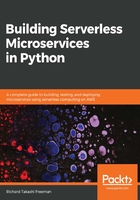
Serverless Microservices Architectures and Patterns
Microservices architectures are based on service. You could think of the microservices as a lightweight version of SOA but enriched with more recent architectures, such as the event-driven architecture, where an event is defined as a state of change that's of interest. In this chapter, you will learn about the monolithic multi-tier architecture and monolithic service-oriented architecture (SOA). We will discuss the benefits and drawbacks of both architectures. We will also look at the microservices background to understand the rationale behind its growth, and compare different architectures.
We will cover the design patterns and principles and introduce the serverless microservice integration patterns. We then cover the communication styles and decomposition microservice patterns, including synchronous and asynchronous communication.
You will then learn how serverless computing in AWS can be used to quickly deploy event-driven computing and microservices in the cloud. We conclude the chapter by setting up your serverless AWS and development environment.
In this chapter we will cover the following topics:
- Understanding different architecture types and patterns
- Virtual machines, containers, and serverless computing
- Overview of microservice integration patterns
- Communication styles and decomposition microservice patterns
- Serverless computing in AWS
- Setting up your serverless environment